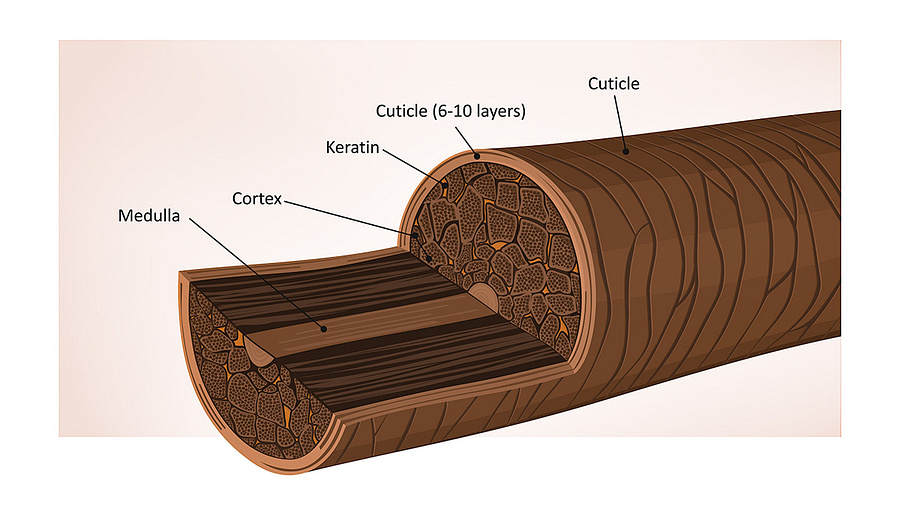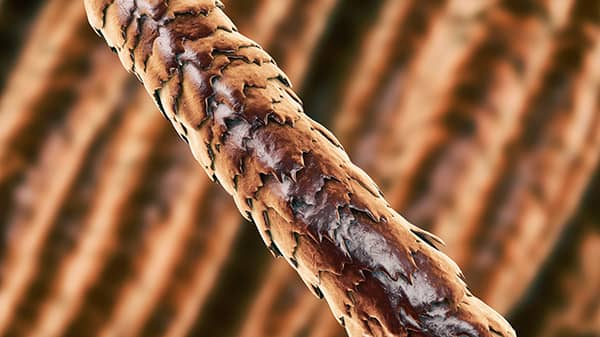Who hasn’t seen a gorgeous hair color on some beautiful stranger on the street or a chic Instagram influencer and wondered if they could pull it off?
We book our salon appointments high on expectations of how our newly-minted color will express our personality, highlight our best features and make us look like the most beautiful version of ourselves.
It’s not too much to ask, right?
Well…maybe. Without knowing the basics about how hair color works we can end up with unrealistic expectations and set ourselves up for disappointment when we get something other than the color we imagined.
I talked with Brian Tiberia, an expert colorist, stylist and studio owner in downtown Royal Oak, Michigan to get a handle on the factors involved in getting a color you love at the salon.
It turns out the first thing we need to understand is the actual structure of hair so we know what kind of magic we’re asking our stylists to perform.
The Anatomy of Your Hair
Hair is made up largely of a protein called keratin, also found in skin and nails. Each strand is produced in a tiny bulb beneath the surface of the scalp at a rate of slightly less than half an inch per month.
Hair strands have 3 layers: an outer protective layer called the cuticle, an inner layer called the cortex and, in thicker hair types, an innermost layer called the medulla.

Cuticle
The cuticle is a thin layer made up of tiny overlapping scales that, when healthy, lay down flat like the tiles on a roof and protect the inner layers of the hair shaft. When hair is damaged, these scales are warped or stripped away, creating gaps that leave the inner core susceptible to further damage. A compromised cuticle makes it harder for hair to hold onto moisture, oils, proteins and, it turns out, hair color.

Cortex
The inner cortex layer is the main part of the hair strand. The bulk of the cortex is made up of long, coiled fibers of keratin strung together in polypeptide chains. It also contains lipids which are fatty oils that moisturize the hair, and the melanin that gives color to the hair.
Medulla
The innermost layer of hair is the medulla, consisting of transparent cells, fatty oils and airspaces. Usually only thicker types of hair contain a medulla.
Bonds
All the components that make up your hair are held together by chemical bonds which give shape, strength and elasticity to the hair strand. Two of the most important types of bonds in hair are disulfide bonds and hydrogen bonds.
Disulfide bonds
Disulfide bonds are one of the strongest bonds found in nature. To break them requires chemicals that permanently reconfigure the structure of proteins. These bonds are what gives strength, elasticity and shape to your hair.
Hydrogen bonds
Hydrogen bonds are weaker chemical bonds and can easily be broken by water and heat which is why you can change the shape and style of your hair when you get it wet or heat style it. Breaking hydrogen bonds regularly can affect the integrity of your hair but is not as damaging as breaking disulfide bonds.
Levels of Lightness
There are 10 levels of hair color, from blackest black (level 1) to the lightest pale yellow (level 10). Knowing these levels will help you communicate exactly what you want when consulting with your colorist.

What about the icy white-blonde seen on so many celebrities and influencers right now? This is achieved with the use of toners (explained below) and not recommended as a goal for lightening alone.
“Since keratin has a pale yellow hue, lifting hair beyond a pale light yellow means almost no keratin is left in the hair strand,” Brian cautions. “This means the hair is essentially ‘fried’ and will be more likely to break, or fall off.”
This is why toners are used to get an icy white hue instead of stripping away all the pigment.

Going Lighter
Going lighter means stripping away the melanin already in the hair and usually calls for bleach.
The most common bleach solutions colorists use contain a mixture of ammonia and peroxide which work as a team. The ammonia is an alkaline agent that causes the cuticle to swell and lift, allowing the solution to penetrate into the hair. Peroxide is an oxidizing agent. Once inside the hair strand, the peroxide reacts with the melanin in a chemical reaction called oxidation that permanently destroys the pigment in melanin molecules.
The higher the concentration of peroxide in the solution, the faster the cuticle will lift allowing more oxidation and more lightening in a shorter amount of time.
Bleach Alternatives
If you only want to go a few shades lighter, your colorist might choose to use an alternative to bleach like a high lift color which may be less damaging. The degree of lightening you can achieve this way is limited, though, and if you’ve previously colored your hair it may not give enough lift to get you to the level you want.
The dark side of lightening is that it’s not just the melanin molecules that get destroyed by the bleach solution. It also breaks the disulfide bonds that give hair its strength and elasticity, damaging the keratin chains and fatty acids that make hair bouncy and shiny.
“Any time you permanently color or bleach your hair, it will be damaging to some extent,” says Brian. “It all comes down to alkalinity. The normal pH of hair is on the acidic end of the pH scale at 4.5 to 5.5. The chemicals used to color hair are alkaline with a pH that can range from 6 to 10 or higher. The higher the alkalinity, the more damage is possible.”
“Any time you permanently color or bleach your hair, it will be damaging to some extent. It all comes down to alkalinity.”
The alkaline agent also compromises the integrity of the protective outer cuticle. When the cuticle swells, the tiny scales that lay uniform and flat in healthy hair peel back and bend. This makes hair porous and susceptible to further damage. When hair becomes more porous, it’s easier for the hair strand to absorb water, minerals and other chemicals that can discolor and weaken the hair.
Because of this, your hair should ideally be as healthy as possible before your color session.
Handle With Care
Some people naturally have more “stubborn” pigment and according to Brian, texture is a big part of it. Thicker textures demand specialized treatment. He prefers a cream or oil-based lightener for textured hair which needs more TLC. He likens using a powder lightener on textured hair to using a harsh detergent on wool. Organic materials like wool, cotton and silk need specific handling and hair is no different.
Your colorist will evaluate your hair’s health before lightening to determine how much it can withstand without becoming overly stressed. It’s very possible to stress your hair to the point of breaking with bleach depending on factors like hair type, condition, previous treatments and the solution used for bleaching so it’s best to leave lightening to the experts.
When Your Colorist Tells You No!
“As colorists we have the knowledge and the tools to do the job. But how far we can take it does depend on your hair,” says Brian. “Celebrities have these massive color corrections that make people think it’s easy but you play an equal part in the process. I don’t start a service until we are both on the same page as far as expectations.”
Sometimes the color you have in mind might be too much for your hair to handle. Be grateful if your colorist tells you no. They know what your hair can handle and what it can’t. If your hair is too unhealthy to take the added stress of a chemical treatment, you likely won’t be happy with the end result. No matter what color you end up with, fried, breaking hair is never a good look.
How Light Can You Get in One Session?

If you want to get from a very dark level to a super light one, it can be a process.
Multiple lightening sessions are more damaging in Brian’s opinion so he prefers to lighten in one session, even if it takes several applications of bleach. This could mean the better part of a day might be needed to get to the level you want.
Healthier and never-processed virgin hair can more easily achieve lift to the lighter levels of 9 or 10 and can also withstand a higher concentration of peroxide.
Another factor has also recently come into play that allows colorists to push the limits of what was previously possible with hair color. This is the invention of bond builders and biomimetics.
Bond Builders and Biomimetics
Bond builders changed the lightening game. Olaplex was the first of its kind. It launched in 2014 and the technology was revolutionary in that it could actually build bridges between the disulfide bonds in hair, preventing and repairing damage done from the application of chemicals.
Since Olaplex came on the market, companies like Redken and others have developed their own bond builders and although they all work by strengthening and preserving bonds, the mechanism is a little different in each.
Bond Builders can be used before, during and after the coloring process to keep hair protected, allowing colorists to achieve more lift than was previously possible.
A new generation of hair treatments has even more recently hit the market. These treatments use biomimetics which work at the molecular level to repair and reconnect the broken keratin polypeptide chains as well as restoring the disulfide bonds in processed hair. Brian swears by K18 which launched in 2020.
“A good way to think about the difference between Oplaplex and K18 is that using Olaplex is like repairing the scratches on a car where using K18 is like rebuilding the engine,” Brian says.
The results of K18 are visible immediately after a quick four minute treatment, improving hair’s health, integrity and shine.
Going Darker
Going darker is less damaging than lightening hair, according to Brian. When you darken hair, you’re actually adding color molecules to the hair strand instead of just stripping pigment away, it can even result in your hair looking shinier.
The outer cuticle still has to be lifted to deposit color into the cortex using an alkaline solution so aftercare is still important for keeping your hair healthy and your color vibrant.
The peroxide used in permanent color solutions not only decolorizes the pigment in melanin but also reacts with the color molecules in the solution to lock them into place.

One important thing to consider before going darker is that it takes a commitment. Getting your hair back to a lighter shade will be a process after having darker pigment deposited over the base color. Going back to a very light shade could require a color correction and possibly take months to achieve.
The Magic of Toning
Permanent color and bleach can only take you so far. Even after getting to the level you want, harsh, brassy orange tones can show up depending on how the chemicals reacted with the pigment in your hair. Neutralizing and adjusting these tones to the perfect shade calls for a special service called a toner.
How Toners Work
Two types of melanin produce the unique color of your hair. We all have a different ratio of these melanins which are genetically determined.
Eumelanin contains a pigment that gives hair a black color and pheomelanin produces shades of red. If your hair contains mostly eumelanin, your natural hair color will be black or dark brown. If you have more pheomelanin in your hair, it will be some shade of red. Blonde hair results from a small amount of pheomelanin with no black eumelanin.
Bleach solutions mainly oxidize the eumelanin in hair which shatters the black color molecules. This leaves a higher ratio of red pheomelanin behind. The unfortunate result can be an unnatural shade of brassy yellow or orange. Instead of further bleaching the hair to the point of breakage to get rid of the pheomelanin, colorists use a toner.
Toners are solutions that come in a wide array of colors. Your stylist uses their expert knowledge in color theory to choose the exact combination of toners to achieve the look you want. Toners can enhance and brighten the tones you want in your hair and also neutralize and adjust the unwanted tones. Toners are what transforms a brassy yellow mane into the perfect champagne blonde.

Cool vs Warm Tones
Why do certain shades look so good on some but not on others?
It comes down to tone. No matter the level of pigment in our skin, we all fall on a scale of cool-toned to neutral to warm-toned. If you’re cool-toned, having a warm hair color could make you look washed out and vice versa. Your colorist can help you figure out what kind of tones will suit you best.
How to determine if you are warm, cool toned or neutral
“The biggest complaint most clients have about their natural hair color is that they always want what they don’t have,” says Brian. “People with warm bases want cool tones and vice versa. It’s best to work with your natural color. It’s easier to enhance a color than to neutralize it because as soon as the toner starts to wear off, the underlying color will start coming through.”
Highlighting
Brian likes to create depth in hair color by enhancing the natural base color and adding dimension with techniques like highlights and balayage.
“When you can work with the natural base color, less maintenance is needed,” he explains. “Changing the color completely requires commitment to upkeep and more frequent salon visits.”
Traditional Highlights
A full head of traditional highlights is one way to brighten up your look. Using this technique, your stylist will use foils to separate and lighten sections of hair all the way to the root, leaving some sections of your hair out of the foils. This allows the natural base color to provide contrast and depth. Traditional highlights require frequent trips to the salon because as the root grows out, a harsh line of demarcation will show.

Root Smudging
One way to lessen the upkeep on highlights is to do a root smudge. This is an application of a toner matching your natural color that will help erase or blur the line of demarcation. Root smudging helps the root blend in more softly and makes new growth less obvious.
Babylights
Babylights are an alternative to traditional highlights that give hair a natural, all-over brightness. This technique lightens tiny sections of strands all over the head. These brightened strands blend in seamlessly with the base color and grow out with a more natural look. Paired with a root smudge, baby lights can be fairly low-maintanence.
Balayage
If you want low-key maintenance all the way, you may want to opt for balayage. Using this technique, your colorist will hand-paint strategic sections of your hair with lightener. The highlights resulting from this technique are multidimensional and don’t reach all the way to the root allowing for a blended look that will grow out beautifully.

Keeping Color Looking Great After Service
Rich, vibrant color and hair health go hand in hand. How well you take care of your hair in between treatments will be a big factor in the quality of your color and how long it lasts.
Here are Brian’s 6 Best Tips for Keeping Hair Healthy Between Treatments
1. Get Regular Trims
“Getting regular trims is a must. Split ends keep advancing up the hair strand until they’re cut off—similar to how the frayed end of a piece of thread will keep unraveling until you snip the end off and get a nice sharp point again.” Frequent trims are especially important when you lighten your hair because of the damage inflicted on the cuticle.
2. Get Glossed
Hair glosses are salon treatments that keep your color vibrant between color appointments.
“Aftercare is crucial to keeping your color looking good,” Brian explains. “I 100% recommend doing glosses. They’re acidic treatments so they help to reseal the cuticle. They add incredible shine and also recalibrate and correct the tone which refreshes your color.”
The results of a glossing treatment typically last about 4-6 weeks depending on how often you wash your hair.
3. Learn the Basics of Washing Your Hair
Sulfates are harsh ingredients found in many well-known shampoo brands that will strip the color from your hair. Check the labels of shampoos and conditioners and try to find those that are sulfate-free and have a pH of 4.5 to 5.5. Many higher-end brands have shampoos and conditioners specially formulated for color-treated hair.

The higher relative pH of water can also open the cuticle exposing your hair to minerals in water that can cause discoloration. Maintain your color as long as possible by using a filter for your showerhead or a whole-house water softener to remove minerals from your water.
4. Ask For a Malibu Treatment
Water’s neutral pH of 7 is still more alkaline than hair’s natural pH. This means even the water from your shower can make your hair less vibrant and healthy over time— especially if you have hard water.
Hard water contains lots of minerals like calcium, magnesium and iron which get into the hair during washing, weighing it down and making it brassy, dry and brittle. When your color starts to take on a brassy hue from your tap water, ask your stylist for a Malibu treatment.
MalibuC is a salon treatment that uses crystallized vitamin C to remove minerals and other harsh chemicals like chlorine that discolor hair. A one-time treatment will leave hair instantly shinier, lighter and brighter.
5. Do Regular Oil Treatments
Hot oil treatments help restore moisture to dry, chemically damaged hair and also protect hair by sealing the cuticle and preventing the loss of protein. You can find tons of ready made hot oil treatments online, at the salon or even at your local CVS. You can also use coconut oil for an easy DIY treatment.
6. Minimize Damage Caused by Heat Styling
Heating hair with styling tools breaks the hydrogen bonds, allowing hair to be reshaped. This is why your hair, once curled or straightened, will usually keep its shape until it’s washed and the hydrogen bonds are reformed.
It’s important to always use a heat protectant when heat styling your hair. Heat protectants come in a variety of formulas from sprays to creams to serums but all of them work to provide a protective barrier against high temperatures. Most claim to protect hair up to a temperature of 400 degrees or higher but try to use the lowest heat setting that works for your hair when heat styling.
How much heat your hair can take depends on your hair type and condition but higher temperatures pose a greater risk for damage. Taking breaks from heat styling also helps hair heal in between color appointments so if you can get away with it, try not to heat style your hair every day.
Conclusion
Getting a color you love at the salon is absolutely possible—especially when you understand the process. Knowing the science behind hair color means you’ll be able to communicate what you want to your stylist and have realistic expectations for your hair’s type and condition.
It also means knowing how to keep your hair as healthy as possible between appointments. After all, even when your stylist works pure color magic, at the end of the day you take your hair home with you so good hair color is always a collaboration.

About Brian
Brian Tiberia started his journey into the hair industry at the Douglas J Aveda Institute and has since taken every opportunity to grow his skill set and earn a spot behind the chair. This refinement of skills comes from a hard work ethic and attention to detail.
He likes to create looks that can be personalized to each guest and will meticulously break down a style to make sure it fits your lifestyle, personality and price range. Brian would describe himself as down-to-earth yet reserved, light-hearted but blunt. He takes his career seriously and finds pride in making sure guests leave more educated about their hair than when they arrived. For those wondering—INTJ-T.



